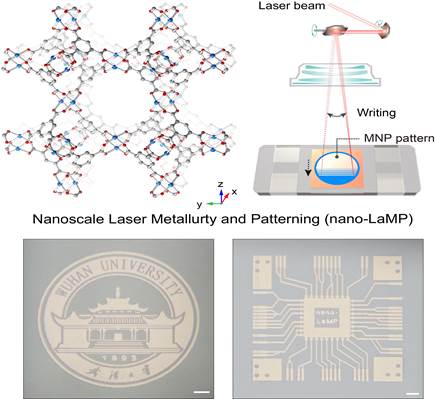金属纳米晶粒是制备光电子器件的重要原料。但金属纳米晶粒活性高、极易被氧化,制备过程往往需要溶液、真空或惰性气氛保护,因此制造工艺复杂,难以大规模应用。新葡的京集团35222vip邓鹤翔教授与工业科学研究院程佳瑞教授团队合作,采用金属有机框架材料作为原料,利用激光成功的制备了颗粒大小均一的金属纳米晶粒。通过程序控制激光的开闭和光斑的移动实现了图案的制备,仅数十秒即可打印出由金属纳米晶粒构成的晶圆级别大小的芯片,整个过程完全在空气中进行,所需激光功率不到5瓦(图一),非常适合规模化生产。
金属有机框架材料(Metal-organic Framework, MOF)由金属与含碳有机配体构筑。目前大部分研究集中在MOF中有机成分上,而结构中丰富的金属离子尚未充分利用。此项工作提出了激光纳米金属冶炼及图案化方法(Nanoscale Laser Metallurgy and Patterning, 简称nano-LaMP),以MOF为原料的实现了空气环境下的金属纳米颗粒制备和同步图案打印。在反应过程中, MOF晶体内有序排列的金属离子和有机配体分别作为金属源和还原剂。纳秒脉冲激光器则负责将能量精准地投送到指定位置,为金属还原提供能量。MOF晶体高效吸收激光后产生局域高温,金属离子被迅速还原并从MOF丰富的孔道中喷射出来,在基底上沉积并迅速冷却形成金属纳米晶粒。nano-LaMP方法展现出较好的普适性,能够基于含有不同金属离子的MOF晶体制备出铁,钴,镍,铜,锌,镉,铟,铅和铋九种金属纳米晶粒及其图案。其中,基于铜纳米晶粒的表面增强拉曼效应芯片在对多种生物分子的检测中提供极低的检测限(10-12 M)。
nano-LaMP结合了激光和MOF材料的优点,为芯片制造提供了节能,环保,快速以及灵活的新方法。该工作在美国化学会志(Journal of the American Chemical Society,JACS)上发表,论文题目为“Nanoscale Laser Metallurgy and Patterning in Air Using MOFs”,并被选中为杂志封面。江浩庆博士后为该论文的第一作者。该工作获得了国家自然科学基金,国家重点研发计划,和新葡的京集团35222vip创新团队项目的资助,以及上海光源(SSRF),新葡的京集团35222vip大型仪器共享平台以及新葡的京集团35222vip测试中心的支持。课题组网站:http://hdeng.whu.edu.cn/。

图一:激光照射金属有机框架材料(MOF)产生金属纳米晶粒及芯片打印
English Version:
Fast printing of nano-devices by laser metallurgy of MOF
Metal nanoparticles (MNPs) are critical ingredient for the fabrication of devices on nanoscale. However, solvent, vacuum or inert atmosphere are usually used for the preparation of MNPs, due to their sensitivity to oxygen in air, which limit their application in large scale. A team led by Hexiang Deng in College of Chemistry and Molecular Sciences and Gary J. Cheng in the Institute of Technological Sciences, both from Wuhan University, reported a new method for the production of uniform metal nanoparticles in air using metal-organic frameworks (MOFs) as precursor with laser as the energy source. This method, named as Nanoscale Laser Metallurgy and Patterning (nano-LaMP), allows for the printing of MNP patterns in wafer-scale size within tens of seconds, consuming only 5-Watt power (Figure 1), ideally suited for large scale fabrication.
MOFs are constructed by orderly spaced metal ions and carbonaceous linkers. The metal ions in the structure remain underdeveloped, albeit extensive research on the organic component. In this study, the orderly spaced metal ions and organic linkers in MOF function as metal source and reductant, respectively. The nanosecond pulsed laser precisely deliver patches of energy to MOF crystals. High temperature was generated instantly at local position due to the efficient light absorption by MOFs, where metal ions were reduced and sputtered out from the porous structure, followed by condensed as metal nanoparticles. Nanoparticles of nine different metals, Fe, Co, Ni, Cu, Zn, Cd, In, Pb and Bi, and patterns were successfully produced from the corresponding MOF crystals by nano-LaMP. Surface enhanced Raman scattering (SERS) chips constructed by Cu nanoparticle patterns on glass using this method exhibited exceptionally low detection limit (10-12 M) for biomolecules.
The nano-LaMP method combines the advantages of laser and MOFs, offering new choice for the fabrication of nano-devices in a fast, economic, efficient and flexible manner. This work, with the title “Nanoscale Laser Metallurgy and Patterning in Air Using MOFs”, was recently published on the Journal of the American Chemical Society and selected as one of the cover story, with Haoqing Jiang being the first author. This research supported by National Key R&D Program of China), Natural Science Foundation of China and the Innovation Team of Wuhan University. Shanghai Synchrotron Radiation Facility (SSRF), the Sharing Platform for Large-scale Instruments and the Test Center of Wuhan University provide help in material characterizations.
Article link:https://pubs.acs.org.ccindex.cn/doi/10.1021/jacs.9b00355
Group website:http://hdeng.whu.edu.cn/
通讯员:江浩庆 日期:2019年4月1日